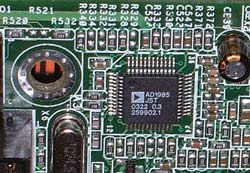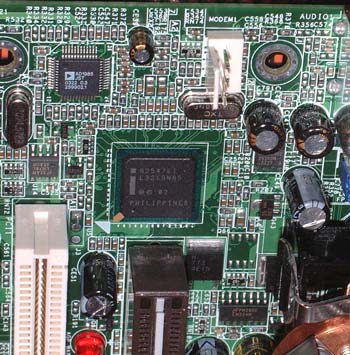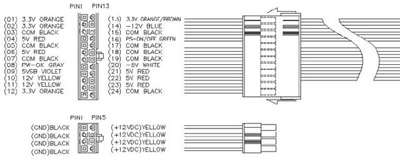Asus PC-DL Deluxe: 875 with Dual Xeons
by Wesley Fink on September 6, 2003 12:06 AM EST- Posted in
- Motherboards
Asus PC-DL: Basic Features
| Asus PC-DL Motherboard Specifications | |
| CPU Interface | Dual Xeon Socket-604 |
| Chipset | Intel 875P North Bridge Intel ICH5R South Bridge |
| Bus Speeds | 133 to 165 (in 1MHz increments) — 533FSB |
| Core Voltages Supported | Default only |
| AGP Voltages Supported | Default only |
| DRAM Voltages Supported | Default only |
| Chipset Voltage | Default only |
| CPU Multiplier Ratios | To 23X with 3.06 CPU |
| Memory Slots | 4 x 184-pin Dual-Channel DDR DIMM Slots Supports both Standard and ECC Memory to PC2700 (DDR333) |
| Expansion Slots | 1 AGP 8X Slot 5 PCI Slots |
| Onboard IDE RAID | Standard ATA 100/66 Supporting up to 4 IDE devices |
| Onboard USB 2.0/IEEE-1394 | 8 USB 2.0 ports supported by ICH5R 2 TI TSB43AB22A Firewire |
| Onboard LAN | Intel 82547EI CSA Gigabit LAN |
| Onboard Audio | ADI AD1985 6-channel |
| Onboard Serial ATA | Intel ICH5R supporting 2 SATA drives Promise PDC20378 for 2 SATA drives |
| Onboard RAID | Intel ICH5R SATA RAID 0,1 Promise 20378 SATA & IDE RAID 0,1, 0+1 |
| BIOS Revision | Release BIOS 1002 |

The feature list certainly looks more like a top-end consumer motherboard than a server board. In fact, the features are basically the same as the P4C800-E that we recently reviewed.

Asus has used the ADI 5.1 audio codec that has become standard on most of their recent boards. ADI is the same codec used by Intel on their 875 boards, and provides automatic switching of sound inputs. In addition, Asus has included a bracket with both coaxial and optical SPDIF out for connection to digital receivers or powered speakers. This is certainly not the kind of on-board audio you would normally expect to find on a Dual processor board.

On-board LAN is provided by Intel’s Gigabit LAN chip providing LAN support on the dedicated CSA bus.

4 USB 2.0 ports are included on the I/O panel with headers for 4 additional USB 2 ports on the motherboard, for a total of 8 USB 2.0 ports provided by the Intel ICH5R South Bridge. Asus provides an accessory bracket with 2 USB ports and a game port. 2 IEEE1384 Firewire ports are available, with one on the I/O panel and one provided on an included accessory bracket.

Serial ATA support is available from both the ICH5R South Bridge and the Promise 20378 controller. Up to 4 individual SATA drives or various combinations of Intel and/or Promise RAID are available. In addition, Asus provides an additional Promise IDE connector that supports up to 2 single drives or 2 ATA133 IDE drives in a RAID configuration. Asus includes four SATA cables, and the 2 sets of power splitters/adapters to allow convenient connection of up to 4 Serial ATA drives.

The Asus PC-DL provides standard IO options on the back panel, plus a firewire port, Gigabit LAN port, and 4 USB 2.0 connectors. A dedicated IO backplate is included. The mini jacks appear to be the standard line-in/line out/mic jacks, but in fact, they automatically configure themselves depending on what you plug into the jacks.
To this point, we could be talking about features on the P4C800-E, but there are several features that immediately tell you this is a Dual Xeon board.
While the PC-DL is a standard ATX configuration and fits the same cases as regular single-processor boards, you will still need a workstation/server power supply. The standard ATX power connector is 20-pin with a 4-pin 12V connector. The PC-DL requires a 24-pin power connection and the 8-pin connector only available on Xeon power supplies.
Click to enlarge.
Fortunately, there are several commonly available power supplies that will meet the requirements. The Vantec Aluminum Stealth 470W and 520W power supplies come with a 24-pin power connector plus a converter for standard 20-pin ATX. Also included are both the standard 4-pin 12V and the 8-pin connector required for Dual-Processor/Server boards like the PC-DL. In addition, both Enermax and Antec have Xeon-style power supplies available at about $50 more than a standard ATX power supply. We do like the Vantec feature of being able to use their power supply for both regular ATX boards and Xeon boards.
Early information about the PC-DL talks about the overclocking capabilities of the board. While the promise is certainly here, the current talk is overly ambitious in our opinion. The only overclocking adjustments on the current board/BIOS combination are FSB adjustment from 133 to 165 and the ability to use a lower multiplier with 3.06 Xeons. Without PCI/AGP lock and any voltage controls at all, even these features are of limited value. When we compare the components used on the PC-DL to those on top P4 boards, it is clear that Asus can provide more of these overclocking features with BIOS updates in the future. However, as it is currently shipping, any claims you see about overclocking are from those accustomed to seeing no overclocking controls at all on a Xeon board. Compared to a standard high-end Pentium 4 board, overclocking options are very limited.











29 Comments
View All Comments
Anonymous User - Monday, September 8, 2003 - link
Xeon DPs are still at the 533 right now. Xeon MPs are worse off at just 400. Faster Xeons are just around the corner though.sprockkets - Monday, September 8, 2003 - link
Aren't the Xenons at 667FSB? But as usual, they share the bandwidth, which is really bad since they crave bandwidth, but good for memory access. But clearly the HT idea is faster.Running though at 800 maybe really too hard to do, or not ?
Anonymous User - Monday, September 8, 2003 - link
Remember Xeons were built for the server market where stability is king. Intel knew this and this is why the 533MHz FSB has stuck around so long. As Intel rolls out more 800Mhz FSB chipsets and P4 chips the 800Mhz FSB Xeon should follow several months later. The same process could be seen back when the 400Mhz FSB Xeons were around.Anonymous User - Monday, September 8, 2003 - link
Well don't take my word for it, wait for the results yourself and then you can admit you are a fool! Clueless kids looking to argue... What a waste of time.Anonymous User - Sunday, September 7, 2003 - link
Is HyperThreading enabled for those Dual Xeons?Anonymous User - Sunday, September 7, 2003 - link
@13 "it would not improve performance enough to even be competitive"lol... what reviews have you been reading? the extra fsb makes a huge difference! THG overclocked the Xeons by 7 mhz and averaged somewhere around 4-4.5% performance increase! That's pretty damn significant. Even bringing the Xeons up to 667 FSB would make it a very good performer!
Anonymous User - Saturday, September 6, 2003 - link
Don't believe everything you read... ESPECIALLY from Intel. Go read THG's review and *maybe* you'll have a better appreciation for why Intel ain't likely to release a 800 MHS FSB Xeon any time soon and it would not improve performance enough to even be competitive when a 2.0 Gig. Opteron/A64 blows the doors off a dual 3.06 Gig. Xeon. If you wanna feel bad... look at how the dual Opteron beats up on a dual Xeon.Anonymous User - Saturday, September 6, 2003 - link
Read the news -- Intel has said it WILL produce 800Mhz FSB Xeons (when is a bit of a question: the last report I read over a month ago said Q1 '04 but they may have moved it up -- that's what this article seems to imply).Anonymous User - Saturday, September 6, 2003 - link
There are technical reasons why the Xeon can't do 800 MHz FSB. Tom's Hardware went into some of the reasons in their dual Xeon test where Opteron also smoked the Xeon even with the new L3 cache. The reality is that Intels current processors have just become obsolete with Opteron and A64. The benches for A64 will show equal or better performance for a single CPU than Opteron. For multi-processor systems above (4) CPUs the Opteron has an advantage over the A64. As the benches show Intel simply has nothing to compete in either the desktop or server segments and soon the A64 will be available in laptop to so Intel needs to get it in gear. Needless to say all Opteron/A64 CPUs will run both 32-bit and 64-bit O/S's. Linux has been available and Windoze will be available soon. AMD has definitety made a qunatum performance leap over Intel this time, no doubt.Anonymous User - Saturday, September 6, 2003 - link
Remember that server boards have to go through more stringent evaluation then desktop boards. I don't think Intel even considers 800Mhz FSB stable enough for their Xeons yet, and it's a shame. There is only so much increasing your L2 cache size can do for you. I don't think you can use 2.4Cs on this board even if you could find a socket adapter -- remember the 'overclocking settings' were limited to 133->165 (that's almost the 667Mhz FSB that Intel might move the Xeon to soon). So you'd be underclocking it by at least 17%, and at that point why bother? That's if you can find some video card that will take a 79Mhz AGP speed -- good luck with that.